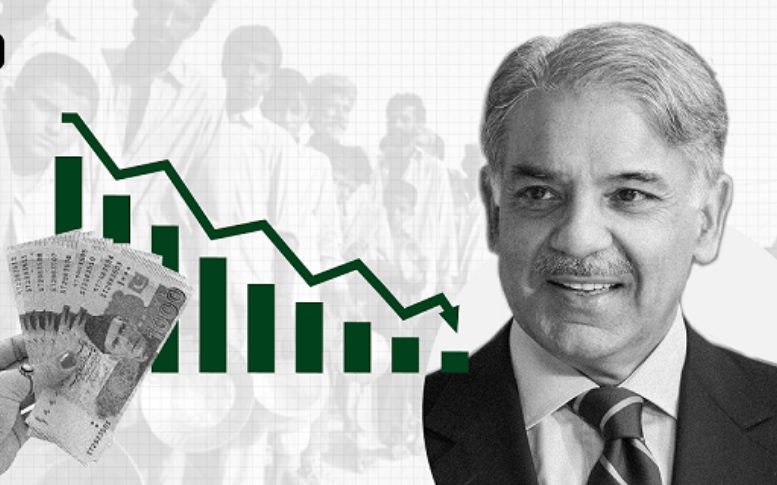Pakistan’s economic growth rate plummeted to 0.3 per cent in the outgoing fiscal year due to severe restrictions imposed on imports in an effort to avoid sovereign default, leaving the industrial sector crippled with spillovers on the services sector, The Express Tribune reported.
The 0.29 per cent growth rate is the lowest increase in the national output in the past four years exposing the mismanagement of the economy that is highly insufficient to meet the needs of 250 million people.
Despite severe floods, the agricultural sector still posted 1.6 per cent growth, beating all forecasts of contraction due to a devastating impact on crops. The industrial sector contracted by 2.94 per cent, The Express Tribune reported.
But the services sector, the single largest sector in the economy, showed nominal growth of 0.9 per cent.
This article is penned by Shehbaz Rana of The Express Tribune. The Express Tribune is the first internationally affiliated newspaper in Pakistan.
The government has missed all sectoral targets, thanks to its economic mismanagement that also caused massive layoffs and contributed towards the 59-year-high inflation rate of 36.4 per cent.

The National Accounts Committee, in a controversial fashion, met on Wednesday night and approved the provisional Gross Domestic Product (GDP) growth rate for the fiscal year 2022-23, ending on June 30. Planning Secretary Zafar Ali Shah chaired the meeting, The Express Tribune reported.
The outgoing fiscal year will be marked in Pakistan’s history as the one when the country experienced devastating floods that washed away crops, a highly mismanaged economy and a steep fall in the purchasing power of the people due to record inflation.
The government has inflicted heavy losses on the economy by devaluing the rupee and increasing the utility prices in the hope of getting a deal from the International Monetary Fund (IMF).
In the end, neither the IMF programme could be revived nor could the economy be saved from disaster.
The provisional Gross Domestic Product (GDP) growth rate for the year 2022-23 is estimated at 0.29 per cent, announced the planning Secretary after a meeting of the National Accounts Committee, The Express Tribune reported.
The government postponed the NAC meeting four times in one week due to disagreement over the increase in national output, according to the sources. Some officials of the Pakistan Bureau of Statistics shuttled from one office to another to reach a consensus, the sources added.
It is a recession in growth, but not an overall recession in the economy, said Nadeem Javaid, chief economist of the Planning Commission, The Express Tribune reported.
There was a broad-based slump in the economic output, mostly because of the government’s mismanagement and also the adverse impact of the floods. The GDP is the monetary value of all goods and services produced in a year, The Express Tribune reported.
The nearly 0.3 per cent growth rate was far lower than the official target of 5 per cent and in line with the estimates of the Ministry of Finance, the State Bank of Pakistan, the International Monetary Fund, the World Bank and the Asian Development Bank.
All the institutions predicted a 0.2 per cent to 0.8 per cent economic growth rate.
The figure is provisional and subject to variations once the final results are available at the end of the fiscal year. The economic growth rate during the last year of the PTI rule was 6 per cent, which was further adjusted by the NAC on Wednesday to 6.1 per cent.
Even the provisional nominal growth rate may become controversial after initial estimates suggested normal contraction. Renowned economist Hafiz Pasha has estimated that the economy has in fact contracted by over 3 per cent during the outgoing fiscal year, The Express Tribune reported.
The details showed that the massive curbs on imports and consumption pulled down the economic growth rate, which has already triggered a serious external sector crisis, an identical pattern witnessed in 2018 when the country fell in the lap of the International Monetary Fund.
Last year, there was a 6.1 per cent growth rate, the end of the Pakistan Tehreek-e-Insaf government, which was the highest in four years. The last time, the country attained a 6.1 per cent growth rate was in 2017-18, the last year of the PML-N rule, which was also driven by consumption and imports and took the country back to the IMF.
During 2017-2018 and 2021-2022, Pakistan’s growth was financed mainly through foreign savings, which is highly unsustainable. Against the official target of attaining a 3.9 per cent growth rate, the agriculture sector is provisionally estimated to grow by 1.6 per cent.
The growth appears surprising and could be the result of adding value addition of around PKR 500 billion in flood expenses, The Express Tribune reported.


